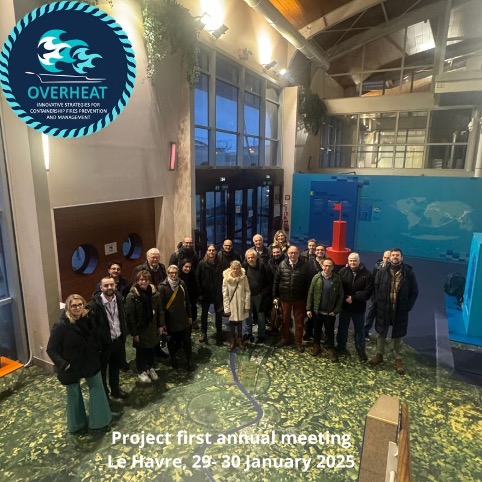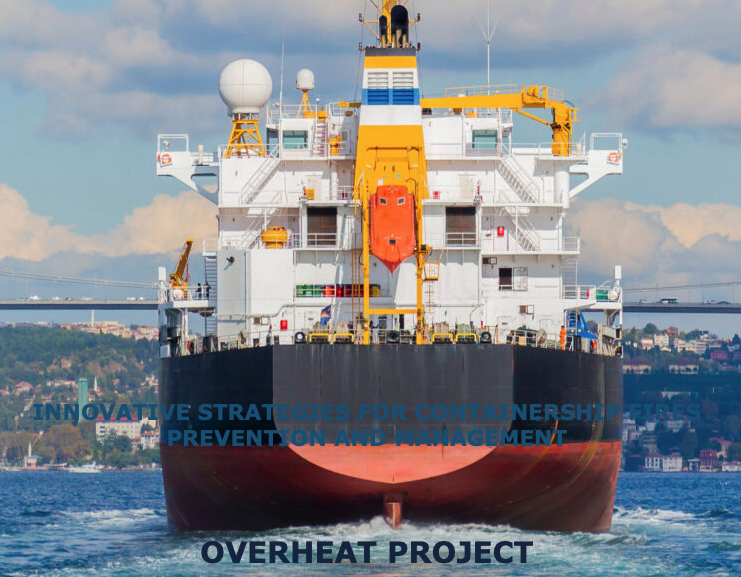(Le Havre, France, January 31st, 2025)
- Finalities
The OVERHEAT project aims to revolutionise digital fire management solutions for container ships by offering a comprehensive, real-time approach that prioritises safety, environmental protection and regulatory compliance. Through a combination of cutting-edge technology and safety culture assessments, this initiative seeks to usher in a new era of fire prevention and management in maritime transport.
- Project Summary
Maritime transport is central to global trade, transporting almost all goods around the world. Container ships face a significant fire safety issue due to the lack of fixed fire detection above the deck. This can lead to catastrophic losses both on land and at sea. The Overheat project aims to provide cutting-edge digital fire management solutions that prioritise safety, environmental protection and regulatory compliance.
- Implementation strategies
Validation activities: Initial evaluation through simulated environments to test the effectiveness of the proposed solutions. Demonstration activities: Real-world implementation to show the feasibility and benefits of the innovative fire management strategies.
Use case development: Identification, description and detailing of specific scenarios to demonstrate the practical application of the solutions.
- Expected outcomes
Navigation incidents, including ship collisions and groundings, damage to ships and vessels caused by debris (in particular lost containers) and harm to marine mammals are significantly reduced.
There is a systematic understanding of the causes of shipping accidents and high standards are set for their prevention.
Automated systems that reduce the human factor as a cause of shipping accidents are introduced on a significant scale and implemented in particular on ships operating in sensitive areas where shipping accidents and incidents would have a particularly negative impact (coastal zones, marine protected areas).
Digital solutions (“smart ships”) that help in accident prevention are developed and integrated into the overall ship architecture and traffic control systems. A link is established with automated and autonomous shipping solutions under development.
Container ship fires can be systematically prevented and, when they occur, will be detected quickly and dealt with safely without resorting to external intervention.
The serious risk to crews, coastal and port communities from toxic combustion products of container ship fires is mitigated. The frequency of fires in container ships is statistically proven to be reduced.

- DITS into OVERHEAT
In the OVERHEAT project, DITS is involved in various work packages. In addition to the mandatory tasks required for all partners, DITS is actively engaged in the following:
WP2 – “State of the Art, Best Practices, and Use Case Definitions”
Extensive work has been carried out in this work package to analyze the current state of fire suppression on ships and examine particularly destructive incidents involving container ships over the past 20 years.
WP3 – “Knowledge Base, Navigation Safety Occurrence Design, and Classification”
In this work package, DITS is the leading partner and has successfully completed two significant milestones outlined in the Grant Agreement:
Task 3.1 – Methods Definition, Processes, and Safety Goals
Task 3.2 – Hazard Identification and Evaluation
WP5 – “Digital Solution Requirements and Data Sharing”
The objectives of this work package are:
- To identify the necessary requirements for a suitable solution.
- To quantify these requirements and establish relevant metrics.
- To propose test specifications to evaluate how the proposed solution meets these requirements.
WP7 – “Simulation and Demonstration Activities”
DITS is actively participating in system testing, and very soon, we will see the first results of the past year’s work in its practical application.
- Notes for Readers
This EU project is funded by the European Union. However, the views and opinions expressed are those of the author(s) only and do not necessarily reflect those of the European Union or the European Executive Agency for Climate, Infrastructure and the Environment (CINEA).

